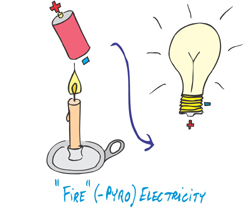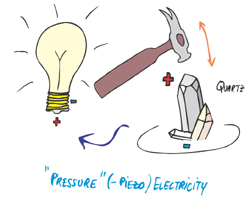Ferroelectrics - Introduction
Ferroelectricity was discovered in the beginning of the last century by J. Valasek in Rochelle salt
(potassium sodium tartrate) which was originally produced in France in 1665 by an apothecary Elie Seignette.
Rochelle salt was originally used in medicine as a mild purgative. Crystals of Rochelle salt were easily grown
and were subsequently used in piezoelectric devices such as crystal microphones and phonograph pickup cartridges.
Historically, ferroelectricity was discovered after piezoelectricity and pyroelectricity. The ceramic BaTiO3
(Barium Titanate), was found by B. Wul and I. M. Goldman. This discovery triggered considerable efforts in search
of additional ferroelectrics having the same perovskite structure. A significant progress in applications was made
possible after the discovery of Lead Zirconate Titanate - Pb(Zr,Ti)O3 or PZT - which has a very strong
piezoelectric response, and a large remnant ferroelectric polarization. Lead-based materials have since become the
dominant compounds in this field.
Later on it was discovered that one could decrease the Curie temperature (ferroelectric-paraelectric transition
temperature) TC of pure BaTiO3 (TC ~ 120 °C) down to room temperature by adding Strontium (Sr).
From there on Ba1-xSrxTiO3 (BST) began to rock the world. The initial interest in
BST thin films was due to its high dielectric constant, low dielectric loss, high dielectric breakdown and composition
dependent Curie temperature enabling it to be in the paraelectric state as well as in the ferroelectric state, all
of which makes it a candidate for replacing SiO2 as charge storage dielectric for DRAMs
(dynamic random access memories), MEMS-switches and varactors in phase shifters.
It is worthwhile to define some basic physical characteristics within ferroelectrics:
1. Pyroelectricity
Pyroelectricty was probably first observed in tourmaline by ancient Greeks, but quantitatively investigated only in
the eighteenth century, during the early studies of electrostatics. Sir David Brewster, a Scottish scientist, was the
first to use the term pyro-(fire)-electricity in 1824 when describing this phenomena in one of his numerous and famous
contributions to the Encyclopaedia Britannica. Pyroelectric materials have a spontaneous polarization whose amplitude
changes under the influence of temperature gradients. The discovery of PZT triggered many applications based on this
phenomenon, such as infrared detection, thermal imaging (absorption of energy resulting in polarisation changes) and
dielectric bolometers.

2. Piezoelectricity
Piezoelectricity was discovered later, around 1880, by Pierre and Jacques Curie who were the first to demonstrate
the generation of electricity (surface charges) on well prepared crystals of quartz as a result of mechanical pressure.
Inversely, when a voltage is applied across a piezoelectric material, it can undergo a mechanical distortion in response.
The beginning of the twentieth century gave birth to most of the classic applications of piezoelectrics, such as
quartz resonators, accelerometers and those already mentioned above. After World War II and following the discovery
of PZT, the advances made in material science allowed the development of numerous applications based on tailored
piezoelectric properties.

3. Ferroelectricity
All ferroelectrics are piezoelectric and pyroelectric, but they additionally possess a reversible, non-volatile
macroscopic spontaneous electric dipole moment in the absence of an external electric field. In simple words,
ferroelectric crystals can be seen as an assembly of batteries with a particular orientation, which remains stable
unless an external electric field is applied to change its direction. Their polar state is a consequence of the
structural transition from a high-temperature, high-symmetry paraelectric phase to a low-temperature, low-symmetry
ferroelectric phase. These materials also behave as high dielectric-constant insulators useful in the development of
capacitors and energy storage materials.

Ferroelectrics, especially perovskites, are truly multifunctional materials widely used in electronic, optical,
acoustic and magnetic components. The first attempts of microwave applications date back to early 1950s.
In the past most of the developed microwave devices have been based on bulk ceramics such as BaTiO3, SrTiO3
and their solid solutions - BaxSr1-xTiO3. However, the high microwave losses associated with the poor quality of
the used ceramics limited their applications in practical microwave devices. With the advances in modern technology
the quality of the epitaxial thin film ferroelectrics has been substantially improved making them qualified for
industrial applications. Although there are many other perovskite systems with promising microwave performances
BST still remains the workhorse for the agile microwave applications since it is more studied both in terms of
electrical performance, manufacturability and reliability. Thin film varactors and bulk acoustic resonators are the
basic components that are used in modern microwave circuits and systems. Ferroelectric varactors have superior
performances, in comparison with the competing semiconductor analogues, both in terms of the Q-factor and tunability;
especially at frequencies above 10-20 GHz. Apart from the high tuning speed they have extremely low leakage currents
offering design flexibilities and low control power consumption. Today there are several small, and well established
companies marketing microwave components based on ferroelectrics. Nevertheless the full potential, especially their
multifunctionality, of these materials is not yet employed.
Want to read more?
A Short History of Ferroelectricity
These text passages on ferroelectrics provided above are part of the book:
Sol-Gel derived Ferroelectric Thin Films for Voltage Tunable Applications
by Arne Lüker, ISBN 978-3-639-31446-5, VDM Publishing House Ltd.
The technologically most important piezoelectric material is PbZr1-xTixO3 (PZT).
It is used extensively in sensor-actuator applications. In recent years, a significant effort has been directed
toward the design of a new ferroelectric or a piezoelectric material that is lead-free, as the toxicity of
Pb poses serious environmental problems. On the next pages we focus our mind on the lead-free perovskite
(Na,K)NbO3-system, the project NOLEAD.




